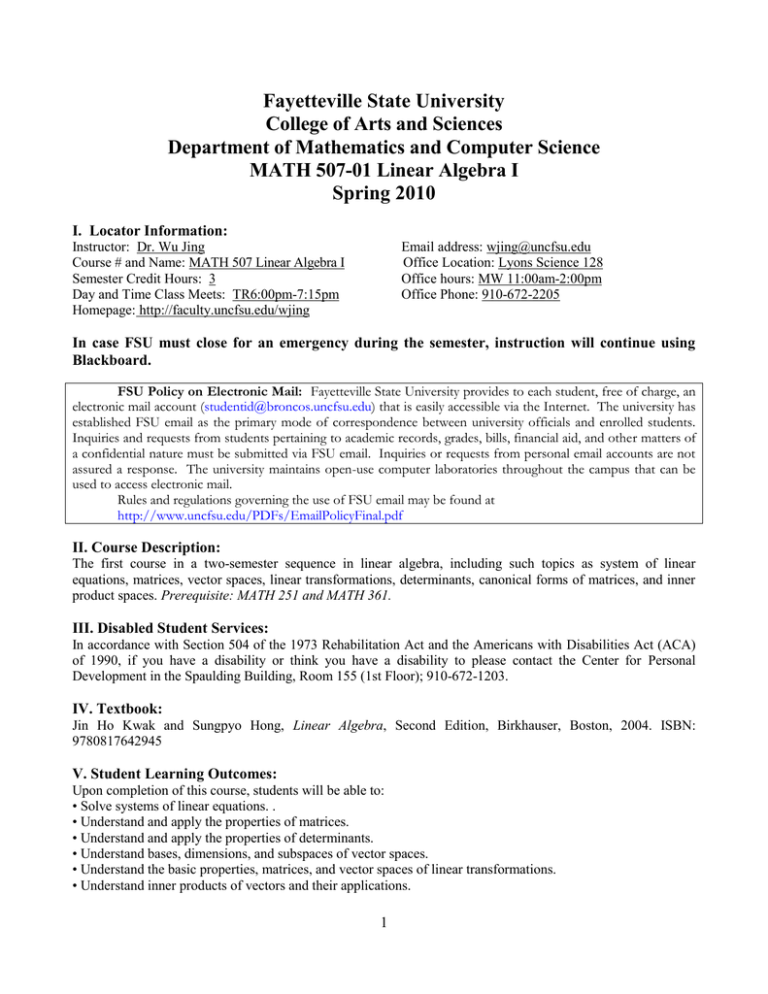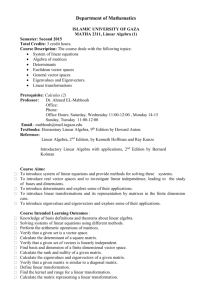
Fayetteville State University
College of Arts and Sciences
Department of Mathematics and Computer Science
MATH 507-01 Linear Algebra I
Spring 2010
I. Locator Information:
Instructor: Dr. Wu Jing
Course # and Name: MATH 507 Linear Algebra I
Semester Credit Hours: 3
Day and Time Class Meets: TR6:00pm-7:15pm
Homepage: http://faculty.uncfsu.edu/wjing
Email address: wjing@uncfsu.edu
Office Location: Lyons Science 128
Office hours: MW 11:00am-2:00pm
Office Phone: 910-672-2205
In case FSU must close for an emergency during the semester, instruction will continue using
Blackboard.
FSU Policy on Electronic Mail: Fayetteville State University provides to each student, free of charge, an
electronic mail account (studentid@broncos.uncfsu.edu) that is easily accessible via the Internet. The university has
established FSU email as the primary mode of correspondence between university officials and enrolled students.
Inquiries and requests from students pertaining to academic records, grades, bills, financial aid, and other matters of
a confidential nature must be submitted via FSU email. Inquiries or requests from personal email accounts are not
assured a response. The university maintains open-use computer laboratories throughout the campus that can be
used to access electronic mail.
Rules and regulations governing the use of FSU email may be found at
http://www.uncfsu.edu/PDFs/EmailPolicyFinal.pdf
II. Course Description:
The first course in a two-semester sequence in linear algebra, including such topics as system of linear
equations, matrices, vector spaces, linear transformations, determinants, canonical forms of matrices, and inner
product spaces. Prerequisite: MATH 251 and MATH 361.
III. Disabled Student Services:
In accordance with Section 504 of the 1973 Rehabilitation Act and the Americans with Disabilities Act (ACA)
of 1990, if you have a disability or think you have a disability to please contact the Center for Personal
Development in the Spaulding Building, Room 155 (1st Floor); 910-672-1203.
IV. Textbook:
Jin Ho Kwak and Sungpyo Hong, Linear Algebra, Second Edition, Birkhauser, Boston, 2004. ISBN:
9780817642945
V. Student Learning Outcomes:
Upon completion of this course, students will be able to:
• Solve systems of linear equations. .
• Understand and apply the properties of matrices.
• Understand and apply the properties of determinants.
• Understand bases, dimensions, and subspaces of vector spaces.
• Understand the basic properties, matrices, and vector spaces of linear transformations.
• Understand inner products of vectors and their applications.
1
VI. Course Requirements and Evaluation Criteria:
1. It is the responsibility of the students to avail themselves of all class meetings, and individual help from
their instructor.
2. Students are responsible for maintaining a notebook of problems selected by the instructor. Students are
encouraged to do as many additional problems as possible.
3. Attendance is MANDATORY. Any student that misses no more than 3 lectures throughout the entire
semester will be award 3 bonus points towards his/her final grade. Attendance will be taken daily.
4. There will be one homework assignment for each chapter. The homework for a chapter is due one week
after the chapter is finished. The lowest homework grade will be dropped. No late homework will be
accepted.
5. There are a numbers of questions in the Discussion Board section of Blackboard. Students are
required to post substantive contributions to the discussion by answering at least 1/2 of the
questions for each chapter on time. Note that simply saying “hello” or “I agree” is not considered
as a substantive contribution.
6. Students are required to create a new thread with your own question for each chapter in the
Discussion Board. For each additional new thread, one bonus point will be added to your
Blackboard Discussion grade.
7. There will be a midterm exam and a final exam. Make-up exam(s) will be given ONLY in the case of
documented absences due to family emergencies, illness or official university functions.
8. Dishonesty on graded assignments will not be tolerated. Students must neither give nor receive help on
work to be graded. The university policy on cheating will be applied to any violations. The minimum
penalty will be a grade of zero on the assignment (including exam).
9. The weights and grading scale given to various activities for evaluation are given below:
Weights:
Blackboard Discussion
Homework
Midterm Exam
Final Exam
Grading Scale:
A 90-100%
B 80-89%
10%
40%
20%
30%
C 70-79%
D 60-69%
F Below 60%
VII. Academic Support Resources:
Extra help or tutoring (provided by a graduate assistant) might be available through the Department of
Mathematics and Computer Science, please see Ms. Briggs at SBE 339 (Tel: 910-672-1294) for detailed
information.
VIII. Tentative Course Outline:
Sections/Topics/Assignments
[1.1] Introduction
[1.2] Gaussian elimination
[1.3] Sums and scalar multiplications of matrices
[1.4] Products of matrices
[1.5] Block matrices
[1.6] Inverse matrices
[1.7] Elementary matrices and finding inverse matrices
[1.8] LDU factorization
[1.9] Applications
Homework #1 & Discussion of Chapter 1 in Discussion Board Due
[2.1] Basic properties of determinant
[2.2] Existence and uniqueness
[2.3] Cofactor expansion
[2.4] Cramer's rule
[2.5] Applications
2
Homework #2 & Discussion of Chapter 2 in Discussion Board Due
Midterm Exam
[3.1] The n-space R and vector spaces
[3.2] Subspaces
[3.3] Bases
[3.4] Dimensions
[3.5] Row and column spaces
[3.6] Rank and nullity
[3.7] Bases for subspaces
[3.8] Invertibility
[3.9] Applications
Homework #3 & Discussion of Chapter 3 in Discussion Board Due
[4.1] Basic properties of linear transformations
[4.2] Invertible linear transformations
[4.3] Matrices of linear transformations
[4.4] Vector spaces of linear transformations
[4.5] Change of bases
[4.6] Similarity
Homework #4 & Discussion of Chapter 4 in Discussion Board Due
[5.1] Dot products and inner products
[5.2] The lengths and angles of vectors
[5.3] Matrix representations of inner products
[5.4] The Gram-Schmidt orthogonalization
[5.5] Projections
[5.6] Orthogonal projections
[5.7] Relations of fundamental subspaces
[5.8] Orthogonal matrices and isometries
[5.9] Applications
Homework #5 & Discussion of Chapter 5 in Discussion Board Due
Final Exam
IX. Teaching Strategies:
The teaching strategies used for the majority of the course are face-to- face lectures. Group discussions and
student presentations may be used.
X. Bibliography:
1. Howard Anton, Elementary Linear Algebra, John Wiley & Sons, Inc., New York, 1994.
2. S. K. Berberian, Linear Algebra, Oxford University Press, New York, 1992.
3. V. V. Prasolov, Problems and Theorems in Linear Algebra, American Mathematical Society, 1994.
4. P. Lancaster and M. Tismenetsky, The Theory of Matrices, Academic Press Inc., New York, 1985.
5. S. I. Grossman, Elementary Linear Algebra, Harcourt College Publishers Publishing Company, 1995.
6. R. Bellman, Introduction to Matrix Analysis, McGraw-Hill, New York, 1960.
7. F. R. Gantmakher, The Theory of Matrices, I,II, Chelsea, New York, 1995.
8. P. R. Halmos, Finite-dimensional vector spaces, Van Nostrand, Princeton, NJ, 1958.
9. A. Horn and C. R. Johnson, Matrix Analysis, Cambridge University Press, Cambridge, 1986.
10. C. G. Cullen, Matrices and Linear Transformations, Addison Wesley, Reading, MA, 1972.
11. Peter J. Olver and Chehrzad Shakiban, Applied Linear Algebra, Pearson Prentice Hall, 2006.
12. W. Keith Nicholson, Linear Algebra with Applications, 5th edition, ITP, 2006.
3










